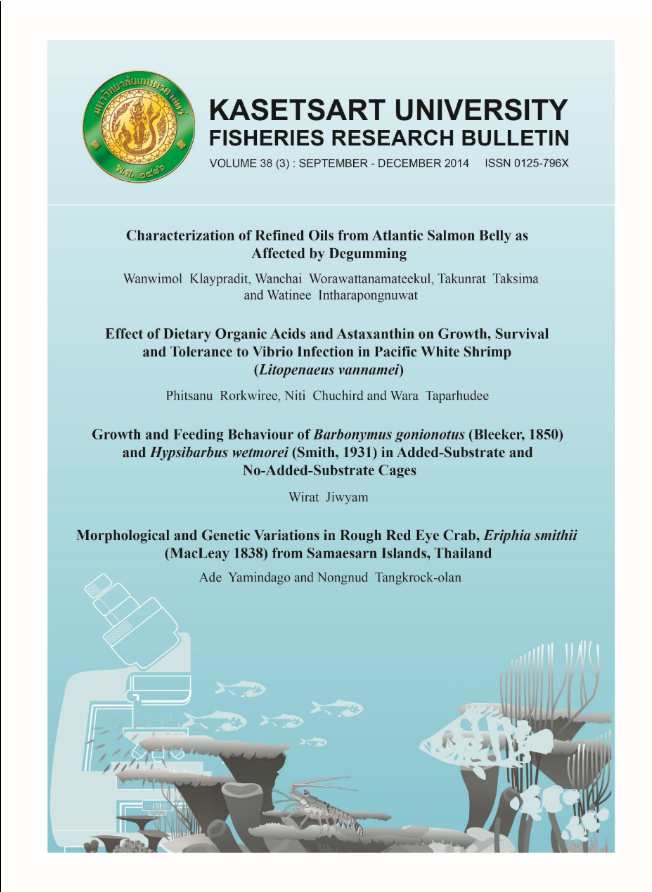Growth and Feeding Behaviour of Barbonymus gonionotus (Bleeker,1850) and Hypsibarbus wetmorei (Smith, 1931) in Added-Substrate and No-Added-Substrate Cages
Main Article Content
Abstract
This research was conducted to study the growth and feeding behaviour of two indigenous herbivorous fish species, Barbonymus gonionotus (Bleeker, 1850) and Hypsibarbus wetmorei (Smith, 1931) under different culture systems. Experimental units were composed of net cages with and without substrates, suspended in a nutrient-enriched pond. Bamboo poles with an approximately submerged surface area equal to the total cage surface area were used as substrates for periphyton growth, and were installed vertically inside the net cages. Survival and growth rates of the fish were evaluated after a 56-day rearing period. The results indicated that the provision of substrates to enhance periphyton production in net cages during the early nursing of B. gonionotus and H wetmorei did not improve growth and survival of the fish stocked at 300 fish m-3. B. gonionotus showed a higher growth rate than H wetmorei (p < 0.05). Average yields of B. gonionotus and H wetmorei obtained in cages were 0.32 and 0.22 kg m-3 month-1, respectively.
Article Details
References
2. Azim, M.E., Wahab, M.A., van Dam, A.A., Beveridge, M.C.M., Verdegem, M.C.J. 2001a. The potential of periphyton based culture of two Indian major carps, rohu Labeo rohita and gonia Labeo gonius (Linnaeus). Aquacult. Res. 32: 209-216.
3. Azim , M.E., Wahab, M.A., van Dam, A.A., Beveridge, M.C.M., Huisman, E.A., Verdegem, M.C.J. 2001b. Optimization of stocking ratios of two Indian major carps, rohu (Labeo rohita Ham.) and catla (Catla catla Ham.) in a periphyton-based aquaculture system. Aquaculture 203: 33-49.
4. Azim, M.E., Verdgem, M.C.J., Rahman, M.M., Wahab, M.A., van Dam, A.A., Beveridge, M.C.M. 2002. Evaluation of polyculture of Indian major carps in periphyton-based ponds. Aquaculture 213: 131-149.
5. Azim, M.E., Wahab, M.A., Biswas, P.K., Asaeda, T., Fujino, T., Verdegem, M.C.J. 2004. The effect of periphyton substrate density on production in freshwater polyculture ponds. Aquaculture 232: 441-453.
6. Beveridge, M.C.M. 1996. Cage Aquaculture, 2nd ed. Fishing News, Oxford. 346 pp.
7. Boyd, C.E. 1979. Water Quality in Warmwater Fish Ponds. Agricultural Experiment Station. Auburn University, Alabama. 359 pp.
8. Boyd, C.E. 1982.Water Quality Management for Pond Fish Culture. Elsevier, Amsterdam. 318 pp.
9. Boyd, C.E., Tucker, C.S. 1992. Water Quality and Pond Soil Analyses for Aquaculture. Auburn University, AL. 183 pp.
10. Coulibaly, A., Ouattara, I.N., Koné, T., N'Douba, V., Snoeks, J., Gooré Bi, G., Kouamélan, E.P. 2007. First results of floating cage culture of the African catfish Heterobranchus longifilis Valenciennes, 1840: Effect of stocking density on survival and growth rates. Aquaculture 263: 61-67.
11. Dempster, P.W., Beveridge, M.C.M., Baird, D.J. 1993. Herbivory in the tilapia Oreochromis niloticus: a comparison of feeding rates on phytoplankton and periphyton. J. Fish. Biol. 43: 385-392.
12. Dempster, P.W., Baird, D.J., Beveridge, M.C.M. 1995. Can fish survive by filter-feeding on microparticles? Energy balance in tilapia grazing on algal suspensions. J. Fish. Biol 47: 7-17.
13. Hem, S., Avit, J.L.B. 1994. First results on 'acadjas enclos' as an extensive aquaculture system (West Africa). Bull. Mar. Sci. 55: 1038-1049.
14. Huchette, S.M.H., Beveridge, M.C.M., Baird, D.J., Ireland, M. 2000. The impacts of grazing by tilapias (Oreochromis niloticus L.) on periphyton communities growing on artificial substrate in cages. Aquaculture 186: 45-60.
15. Huchette, S.M.H., Beveridge, M.C.M. 2003. Technical and economical evaluation of periphyton-based cage culture of tilapia (Oreochromis niloticus) in tropical freshwater cages. Aquaculture 218: 219-234.
16. Keshavanath, P., Ganghadar, B., Ramesh, T.J., Van Rooij, J.M., Beveridge, M.C.M., Baird, D.J., Verdegem, M.C.J., van Dam, A.A. 2001. The potential of artificial reefs to enhance production of herbivorous fish in Indian freshwater ponds-preliminary trials. Aquacult. Res. 32: 189-197.
17. Keshavanath, P., Gangadhar, B., Ramesh, T.J., van Dam, A.A., Beveridge, M.C.M., Verdegem, M.C.J. 2002. The effect of periphyton and supplemental feeding on the production of the indigenous carps Tor khudree and Labeo fimbriatus. Aquaculture 213: 207-218.
18. Keshavanath, P., Gangadhar, B., Ramesh, T.J., van Dam, A.A., Beveridge, M.C.M., Verdegem, M.C.J. 2004. Effects of bamboo substrate and supplemental feeding on growth and production of hybrid red tilapia fingerlings (Oreochromis mossambicus x Oreochromis niloticus). Aquaculture 235: 303-314.
19. Lamberti, G.A., Moore, J.W. 1984. Aquatic insects as primary consumers, pp. 164-195. In: The Ecology of Aquatic Insects. V.H. Resh, D.M. Rosenberg (Eds). Praeger Scientific, New York, pp. 164-195.
20. Ramesh, M.R, Shankar, K.M., Mohan, C.V., Varghese, T.J. 1999. Comparison of three plant substrates for enhancing carp growth through bacterial biofilm. Aquacult. Eng. 19: 119-131.
21. Shankar, K.M., Mohan, C.V. 2001. The potential of biofilm in aquaculture. World Aquac. 32: 62-63.
22. Shrestha, M.K., Knud-Hansen, C.F. 1994. Increasing attached microorganisms biomass as a management strategy for Nile ti1apia (Oreochromis niloticus) production. Aquacult. Eng. 13: 101-108.
23. van Dam, A.A., Beveridge, M.C.M., Azim, M.E., Verdegem, M.C.J. 2002. The potential of fish production based on periphyton. Rev. Fish Biol Fish. 12: 1-31.
24. Uddin, M.S., Milstein,A., Azim, M.E., Wahab, M.A., Verdegem, M., Verreth, J. 2008. Effects of stocking density, periphyton substrate and supplemental feed on biological processes affecting water quality in earthen tilapia-prawn polyculture ponds. Aquacult. Res. 39: 1243-1257.
25. Vidthayanon, C. 2008. Field Guide to Fishes of the Mekong Delta. Mekong River Commission, Vientiane. 288 pp.
26. Vromant, N., Nam, C.O., Ollevier, F. 2002. Growth performance of Barbodes gonionotus (Bleeker) in intensively cultivated rice fields. Aquaculture 212: 167-178.
27. Wahab, M.A., Azim, M.E., Ali, M.H., Beveridge, M.C.M., Khan, S. 1999. The potential of periphyton-based culture of the native major carp calbaush, Labeo calbasa (Hamilton). Aquacult. Res. 30: 409-419.
28. Yakupitiyage, A. 1993. Constraints to the use of plant fodders as fish feed in tropical small-scale tilapia culture system: an overview, pp. 681-689. In: Fish Nutrition in Practice. S.J. Kaushik, P. Luquet (Eds). Colloques Institut National de la Recherche Agronomique vol 61, Paris.

